An Orwellian Reminder
Jun 07, 2013, Updated Dec 10, 2016
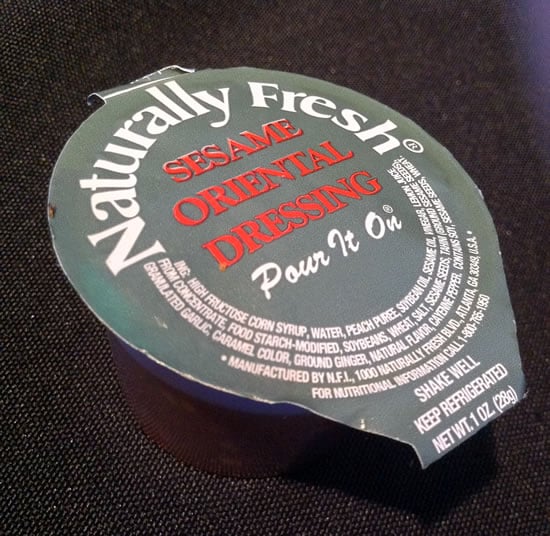
I’ve gotten to the point where any claims on the labels of food packages are an immediate red flag. With all the Orwellian “Doublespeak” surrounding our foods, I now assume that packaged foods are “guilty until proven innocent” when it comes to what’s printed on the box.
Take, for example, this salad dressing I encountered on a recent flight. I was lucky enough to use miles to upgrade to the front of the plane, which meant they gave me lunch. I chose the salmon*, which was served on on a bed of mixed greens, sprinkled with radish, jicama, and mango. It was a far cry from the wilted iceberg lettuce they would have served a few years ago. It was really quite nice, and I was grateful to have a meal.
But the dressing was disappointing. I’m glad that ingredients were listed, because they let me easily see through any marketing hype on the front. The name of the company — not just the product! — is “Naturally Fresh.” It’s even manufactured on “Naturally Fresh Boulevard!” How great! Who wouldn’t want to eat something that’s both “natural” and “fresh?”
But then I read on. I didn’t even have to read past the first ingredient:
High Fructose Corn Syrup, Water, Peach Puree, Soybean Oil, Sesame Oil, Vinegar, Lemon Juice From Concentrate, Food Starch-Modified, Soybeans, Wheat, Salt, Sesame Seeds, Tahini (Ground Sesame Seeds), Granulated Garlic, Caramel Color, Ground Ginger, Natural Flavor, Cayenne Pepper.
Not natural. Not fresh. Not even close.
I skipped the dressing, and my salad was perfectly lovely without it.
—
* I usually avoid farmed salmon, which this likely was, but I was hungry and figured it was a better choice than the likely-factory-farm chicken. Can’t win ’em all.
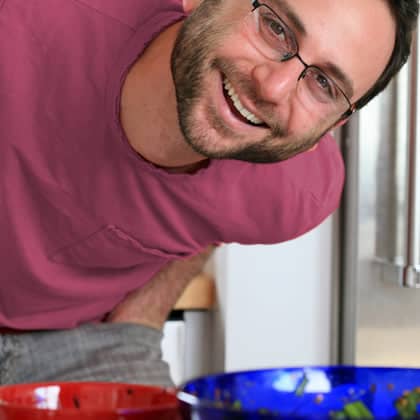
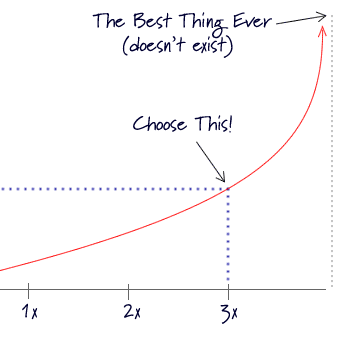

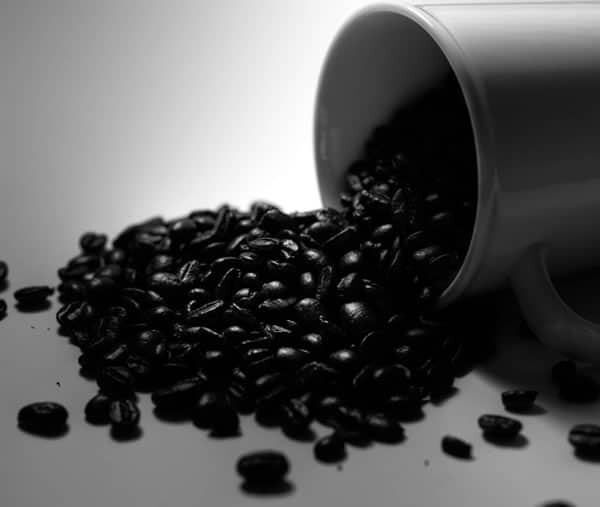
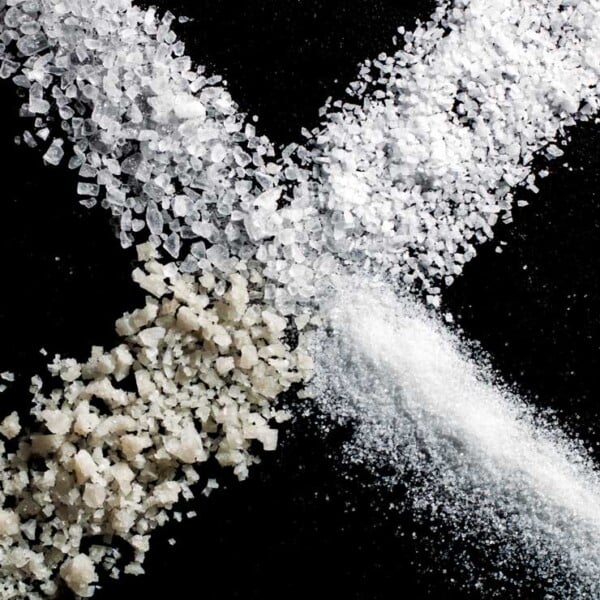





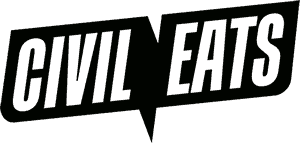









Actually, looking at the ingredents, this looks like a yummy dressing to make myself. Love the combo of spices. Fresh ginger is amamzing. I have learned to read labels, over the last two years and looking at the main ingredents and making it myself. Love your site!
Thanks Brigette! I agree, this should be a very easy dressing to make. Next time I think I’ll bring a little bottle of my own (small enough to get through security…).
hi – can’t “anything” you read can you? thanks for the reminder to always always check that label. I have a question I wonder if you could help me with. I recently learned that the almonds sold in this country have to be sterilized and have been for years. Steralization is done either by steam or chemicals that are some kind of petroleum (I think) by product and have been shown to be carcinogenic. As if that is not bad enough, the label does not have to tell you that the nuts were sterilized or which method was used!! Did you know that? it was certainly news to me. how is one supposed to keep up to date on this information? I have looked at several sources for almonds on-line and none has reported which method was used. I also heard that one is not allowed to sell authentically “raw”… Read more »
Hi Jacquie – I’ve recently heard about almond sterilization, but haven’t done any homework on it just yet. I did recently see a package of almonds from Whole Foods that specifically said they were steamed. I think it was their “365” house brand, which does tend to be a little easier on the budget. 🙂
thanks for the info. now if I only had a Whole Foods near by….. will keep looking.
Hi Andrew,
I’ve fallen off the wagon a bit when it comes to healthy eating over the last few months and have an increase in weight with clothes that no longer fit to prove it. I had literally just been thinking of you and the October challenge and getting started now – rather than waiting until October. Then your latest blog appears in my mailbox…
So this is a great reminder that priority #1 is not to eat anything that requires a label. If that’s not possible then priority #2 is to read the small print on the label and not get fooled by the name, title and/or advertising. The less processed the better.
Hi Chris – Absolutely no reason to wait until October! (Though we will be doing the challenge again, of course). Bravo! 🙂
Labels are so misleading. Its like the free-range chicken label. Free range means they open the door for a few minutes once a week. The chicken doesn’t even have to go outside to be labeled “free-range”
Yes – thanks for bringing this up, Arthur. The key is to find Pastured eggs – and to inquire with the farmers about how they care for their chickens to be sure they’re really humanely raised and actually get to go outdoors. Humane Certified or Animal Welfare Approved eggs are also a good way to go.
I did this recently with a coffee-flavoring product my mom bought for me. She meant it as a nice gesture. I like flavored coffee, and she thought I’d enjoy this. But one look at the ingredient list, and realizing that I could not even PRONOUNCE a single word on it, told me to politely decline it. I’ll do with normal coffee if it means cutting out a teaspoon of pure chemicals and “natural and artificial flavorings.” GROSS! Thanks, but no thanks.
Exactly!
I’m so with you here. As a shopper I usually avoid farmed salmon. Heck I even try to avoid all salmon harvested outside U.S. waters. But (push comes to shove) I will eat most salmon put in front of me. But processed salad dressing is almost always poison. I can’t understand why they can’t sell a tasty salad dressing that oil and vinegar and just a few well placed spices. There’s a market hungry for it. Even Lucy and Ethel knew that… GREG
(http://www.sippitysup.com/choosing-the-right-saafood-buy-american/)
Thanks Greg for posting your link. When picking fish I’m always concerned with how to pick the “correct” fish. Your idea makes sense to me.
Thanks Greg. Wild Alaskan Salmon and Halibut are my go-to fish, because it’s easy to remember that they are caught in cleaner waters and their fisheries are well-managed.
I’ve actually been on flights on American Airlines where they’ve served little bottles of oil & vinegar. Not sure why they can’t do that more often!
Makes sense Renee, same true for beef, they pump them up with antibiotics because cows are grazers, the corn reeks havoc with their guts, so they overdo the meds to keep them “healthy” until slaughter. I wonder if there are sustainable ways to raise your own fish?
People with farm ponds can and do raise their own fish. An ornamental pond would work fine, too, if your garden is organic. Organic Gardening magazine ran an article on ponds a few years ago . . . I don’t remember how large a pond you’d need, or other details, but the info is out there somewhere.
Or buy Asian carp, which is an incredible pest now in eastern Oregon – a lot of them escaped from fish tanks or, more likely, were dumped the way people do excess puppies (or large snakes, in FL); it’s taken over parts of the Harney-Malheur wetlands lakes (and so is wild-caught). I’m sure other parts of the country have similar pest fish that the Wildlife Dept. would be thrilled to sell off.
There’s some really good work being done with closed-loop aquaponics systems. When done well, it can be one of the cleanest and most efficient farming techniques out there. But I don’t think any of them have expanded to particularly large scales yet.
My friend Jim is working on this, actually…
http://www.eatingrules.com/2012/10/urban-farming-the-growing-experience/
One of the biggest concerns of eating our of a fish farm is the amounts of antibiotics the fish are given to prevent bacterial illness due to their close quarters…..and just how often are those containers cleaned?????
The problem with fish farming is in the feed. Because the salmon aren’t benefiting from any “green” feed, their Omega 3’s drop considerably. They are fed corn based pellets, so they have become the equivalent of a large-lot fed steer. Grass fed beef has higher O3’s than corn fed. Same is true for fish.
Paula, thank you. I’ve always heard that farmed salmon was to be avoided in favor of wild caught, but assumed it was only because much farmed fish is raised in dirtier water than wild. I didn’t think about the fish feed resulting in lower Omega3s.
Ah, the fine print! I totally agree and am glad that you occasionally point this out. So many don’t read the ingredients. What I really want to address is the farmed salmon issue. I also have been a wild only person until I started encountering Australians on my travels who all preferred farmed over wild because their wild fish came from polluted waters. Consider, that with the amount of plastic breaking down in the Pacific, to smaller and smaller bits and that salmon are near the top of the food chain, wild fish would seem to be increasingly a bad bet for healthy eating. Alas, I have yet to encounter an ‘organic’ or sustainable/local version of fish farming like there is for other protein sources and I believe there is a strong market for such a product.